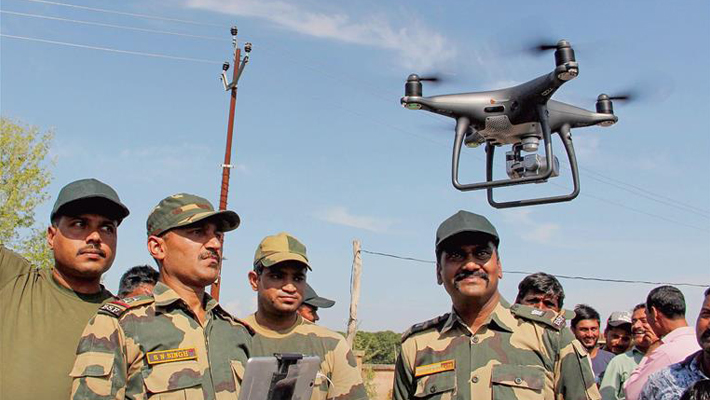
Predator drones are military unmanned aerial vehicles (UAVs) that are used to identify, locate, and track targets. They are outfitted with high-resolution cameras and sensors that allow them to swiftly and precisely survey broad regions. This technology can identify unlawful activities such as drug and people trafficking at borders, making it a useful border security tool. They can be outfitted with weaponry, allowing them to be utilized in a defensive role in addition to monitoring. This implies they may be utilized to discourage and even respond to possible border threats, making them an effective border security tool. Since 2005, the US Border Patrol has used drones to monitor the Southwest border for illegal crossings and drug smuggling.
While drones can help with border security, there are certain reservations regarding their use. Drones, for example, have been deployed to spy on people near the border, prompting privacy concerns. It is also possible that drones will be utilized to carry narcotics or other items across the border. Unmanned aerial vehicles (UAVs), sometimes known as drones, are aircraft that do not have a human pilot on board. They are either piloted by a human on the ground or autonomously by computers and sensors. Drones were first used for border surveillance along the US-Mexico border in Texas in 1990. The mission's purpose was to interdict drugs. Since 2005, US Customs and Border Protection (CBP) have deployed a Predator B variant of the military drone along the border. Microsoft founder Bill Gates is bullish about drones, saying, "Drones overall will be more impactful than I think people recognize, in positive ways to help society."
In this day and age of technical developments, the use of Predator drones has transformed border security. These unmanned aerial vehicles (UAVs) with advanced monitoring capabilities have various benefits for improving border security.
Unmatched Surveillance Capabilities
Predator drones are equipped with cutting-edge surveillance technologies that provide unparalleled situational awareness for border security agencies. With their high-resolution cameras, infrared sensors, and advanced radar systems, these drones can effectively monitor vast stretches of border areas in real time. The drones' cameras can capture images and record videos with exceptional clarity, allowing border patrol officers to detect and identify potential threats, such as smugglers, illegal border crossings, or suspicious activities.
The ability of predator drones to operate at high altitudes grants them a wide field of view, enabling surveillance over large expanses of rugged and remote border regions that are otherwise challenging to monitor using traditional methods. This enhanced aerial surveillance ensures that border security agencies can swiftly respond to any security breach, facilitating timely intervention and minimizing potential risk.
Rapid Deployment and Flexibility
One of the key advantages of using predator drones for border security is their rapid deployment and flexibility. Unlike manned aircraft or ground patrols, drones can be launched quickly and effortlessly, providing immediate coverage of border regions. This agility is crucial in addressing emerging security threats promptly.
Moreover, the versatility of predator drones allows them to adapt to different operational requirements. They can be equipped with additional specialized equipment such as infrared cameras, radar systems, and even communication interception tools, depending on the specific border security needs. This adaptability ensures that drones can effectively address various challenges, from monitoring illicit activities to providing support during natural disasters or search and rescue operations.
Cost-Effective Solution
Implementing predator drones as a part of border security strategies can offer significant cost savings in the long run. While the initial investment may be substantial, the operational costs of drones are considerably lower compared to traditional manned surveillance methods. Drones eliminate the need for extensive infrastructure, such as manned aircraft hangars or ground petrol stations, and the associated maintenance costs.
Moreover, predator drones can remain airborne for extended periods, allowing for continuous monitoring without incurring additional costs typically associated with manned flights. The ability to cover large areas from a central control station further reduces manpower requirements, enabling border security agencies to optimize resource allocation.
Predator drones have emerged as a game-changing technology in border security. The advanced surveillance capabilities, rapid deployment, and cost-effectiveness make them a valuable asset for border security agencies worldwide. By providing unmatched situational awareness, predator drones empower border patrol officers to detect, assess, and respond to potential threats in real time, enhancing the overall effectiveness of border security operations.
However, it is important to recognize that predator drones offer numerous advantages, they should be utilized with other border security measures. Human intelligence, ground patrols, and collaborative efforts with neighbouring countries remain crucial components of a comprehensive border security strategy.
As technology continues to evolve, it is anticipated that predator drones will undergo further enhancements, incorporating artificial intelligence and automation, which will further optimize their performance in border surveillance. Ultimately, the integration of predator drones into border security systems exemplifies the potential of technology to bolster national security, safeguard borders, and protect the interests of nations in an ever-evolving global landscape.







